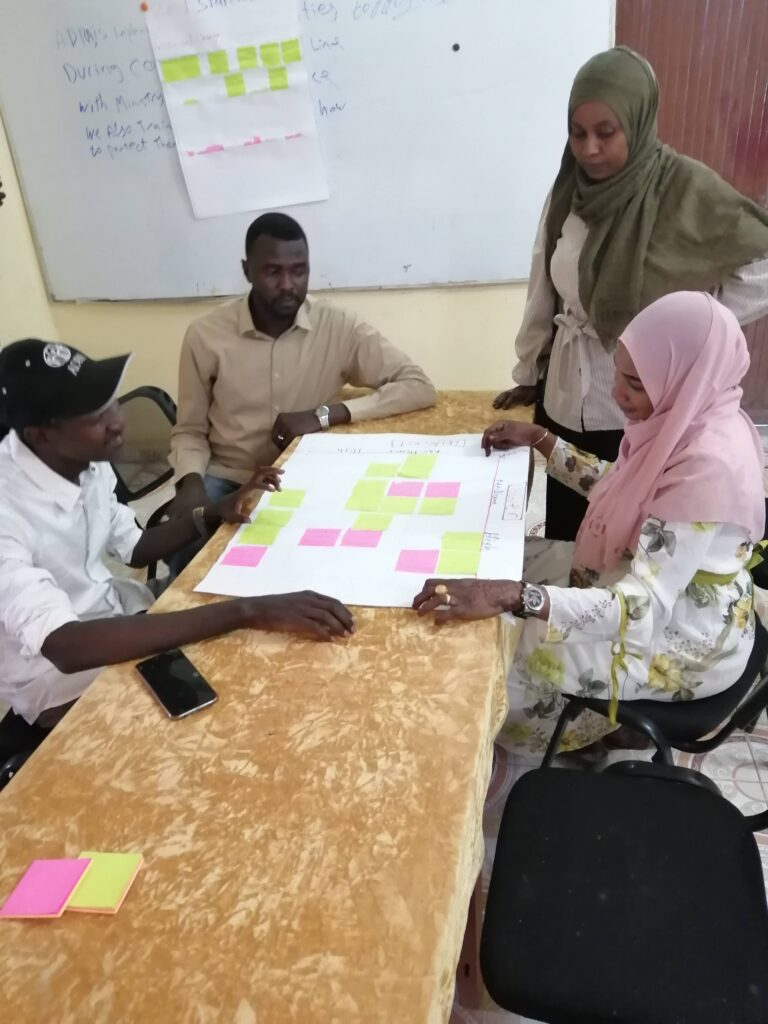What is an Organizational Monitoring & Evaluation Policy? (And how do I make it useful?)
Are you looking to improve your organization’s practices and processes around monitoring and evaluation? Let’s learn about Organizational Monitoring and Evaluation policies.
At Salanga, we recently completed a training session for NGOs on this topic so we thought we would share some key insights.
A Monitoring and Evaluation Policy (also referred to as Standards or Guidelines) is a collection of the rules, principles, operational standards and guidelines that are designed by an organization to achieve its goals around monitoring and evaluation, and often also accountability, research and learning.
Note: At Salanga, we often use the term MEAL (monitoring, evaluation, accountability and learning), as we think it’s important to emphasize the role that accountability and learning play in monitoring and evaluation. Other organizations may call this MEL (monitoring, evaluation and learning) or MERL (monitoring, evaluation, research and learning). For the purposes of this article, we will stick with Monitoring and Evaluation.

Monitoring and Evaluation Policies are formulated to direct and exert influence on all the major monitoring and evaluation decisions to be made within the organization and helps keep all MEAL activities within a set of established boundaries. Having a monitoring and evaluation policy can help set clear expectations and puts in writing what the organization expects from employees in terms of the behavior, actions, and processes they take in specific scenarios around monitoring and evaluation. Monitoring and Evaluation Policies tend to describe what you SHOULD do or NEED to do within your organization around monitoring and evaluation.
Who is a Monitoring and Evaluation Policy for?
A Monitoring and Evaluation Policy is primarily intended for project implementer and program staff who will be involved in monitoring and evaluation of project implementation (think Mangers, Officers, Partner monitoring and evaluation officers and partner programing and management staff). Communications, Fundraising and Business Development staff may also be interested in a Monitoring and Evaluation Policy to better understand the integration of monitoring and evaluation in their activities. Finance staff may also use it as a reference for budgeting monitoring and evaluation activities in projects.

How should a Monitoring and Evaluation Policy be used?
A Monitoring and Evaluation Policy is intended to be used as a reference document throughout the project. I like to keep them generally short and list them as annexes and checklists so they can be printed and or used as stand-alone reference documents as needed.
So now that you know a little bit more about what a Monitoring and Evaluation Organizational Policy is, how do you know if you need one/s for your organization? Where does one start?
Monitoring & Evaluation and the McKinsey Framework
A good place to start is with the McKinsey Framework. The McKinsey framework is a model for organizational effectiveness developed in the 1970’s and it can provide a helpful structure for thinking about different elements of an organizational Monitoring and Evaluation Policy. For more information on the Mckinsey Framework you can check it out here: https://www.mindtools.com/pages/article/newSTR_91.htm
The McKinsey model includes 7 different elements which you can see below in the photo.

For the purpose of monitoring and evaluation I’ve revised the 7 elements down to 4. Let’s look at each of the elements in more detail and see how they can relate to Monitoring and Evaluation Policies:
- SHARED VALUES & STYLE: these represent the core values of the organization and reflect its general work ethic. They are also called “principles” and they can affect how monitoring and evaluation is done within your organization and what gets prioritized. Style refers to the leadership and management style within monitoring and evaluation.
- STRATEGY AND SYSTEMS: this is your organization’s plan for building and maintaining an organizational monitoring and evaluation system. It also includes the daily procedures and requirements in monitoring and evaluation that staff use to get the job done in monitoring and evaluation.
- STRUCTURE AND STAFFING: this is how your company is organized (how departments and teams are structured, including who reports to whom) in monitoring and evaluation.
- SKILLS: these are the actual skills and competencies of the organization’s employees in monitoring and evaluation and those of your partners or stakeholders.
Sections of an Organizational Monitoring and Evaluation Policy
Now let’s look at some of the most common sections included in Monitoring and Evaluation policies/guidelines organized by the McKinsey Framework.
1. MONITORING AND EVALUATION VALUES & STYLE:
- An introduction to the key purpose of monitoring and evaluation within the organization;
- A list of key guiding principles that showcase your monitoring and evaluation values and how they might be applied in the organization;
- A list of definitions and common terms used in monitoring and evaluation that relate to your organization.
2. MONITORING AND EVALUATION STRATEGY & SYSTEMS:
- Details on technology options and software/hardware that may be used for data collection, management and reporting within your organization;
- Guidance on reporting and sharing of data for project learning;
- A description of key standards or requirements that projects are expected to have in relation to monitoring and evaluation. This can include guidance or requirements around:
- The use of Logic Models and the creation of results statements.
- The use of Performance Measurement Frameworks for projects and how indicators should be designed and monitored.
- How monitoring and evaluation should be budgeted in projects.
- How projects should ensure privacy and confidentiality of data.
- What sense-making or reflection processes should be carried out to understand and learn from the data that is collected.
- How projects should budget for monitoring and evaluation activities (i.e. how much should they spend and on what?)
3. MONITORING AND EVALUATION STRUCTURE & STAFFING:
- Guidance on how to hire monitoring and evaluation staff = this could include key questions to ask potential monitoring and evaluation candidates or key skills needed;
- Guidance on the processes for managing monitoring and evaluation support to projects;
- A description of the Monitoring and Evaluation Unit (what staff are involved, roles and responsibilities, functions);
- A description of how the Monitoring and Evaluation Unit staff provide support or how they engage with other staff/departments within the organization.
4. MONITORING AND EVALUATION SKILLS:
- A Monitoring and Evaluation Skill Assessment Form that staff can use to review strengths and weaknesses on the team (often done in Excel);
- A list of training materials or resources that your monitoring and evaluation staff can utilize to increase their skills.
Some Monitoring and Evaluation Policies are also based on international norms and standards in evaluation: For example – OECD/DAC, American Evaluation Association, UNEG, or international benchmarks. It’s also important to think about the scope of your Policy.
- Does this particular policy or guideline apply to all programs in my organization or only specific ones?
- Are there programs which when funded by a particular donor are excluded?
For some ideas of how Monitoring and Evaluation organizational policy documents are structured, check out the following documents:
In upcoming articles, we will explore each of the four elements as it relates to Monitoring and Evaluation and I’ll provide key reflection questions and examples that you can use to kick-start your own journey towards creating meaningful Monitoring and Evaluation policies!
Hope you enjoyed! Let me know your thoughts.
Cheers,

Paula Richardson, Director of Collaborative Evaluation, Learning and Impact





